Darya Ganj – a confluence of Mughal, Colonial and Contemporary era

Rajkumari Sharma Tankha
Delhi has had a long history of it being created and destroyed. But every time an old city got destroyed, a part of it remained and soon got assimilated with the new one. This is the reason you find new elements juxtaposed with the old here, in all aspects, be it lifestyle, buildings, culture and traditions or the cuisine.
Exploring Darya Ganj, located in the walled city of Shahjahanabad, is an exhilarating experience. It is amazing that despite the two-lane parking of vehicles on the roads, there is ample space for the people to walk. The roads are that wide.
Standing outside the erstwhile City Wall is Mortello Tower. It was built by the British sometime in early 19th century to fortify the city. It can be reached through a bridge. It is 17m wide at the bottom and served as an effective safety tool for the city denizens at that time.
Mortello Tower
Significantly, Mortello Tower is the point where the city ended and the Darya (river) Yamuna began. The city thrived inside the wall, while this place served as a huge ganj (wholesale market). Remember, during those times waterways were the main means for transport of almost all kinds of goods, especially the heavy goods, which were unloaded at the Yamuna ghats here and hence it made sense to sell them here itself; it cut the cost of further transportation. Hence the area came to be called Darya Ganj.
Historians believe that Darya Ganj existed even before Shahjahanabad was built and always functioned as a wholesale market. It was a part of Firozabad earlier. When Shahjahan built Shahjahanabad this area got incorporated into it.
The City Wall
When British came, they set up a cantonment at Darya Ganj. But it was not heavily built up, it had lots of open spaces. During the 1857 revolt lots of European families living here were killed, that was when the area got emptied to a large extent.
Later, sometime around 1920-30 when the British decided to develop New Delhi as the new Capital of India, Darya Ganj area was also redeveloped, mainly for fulfilling the residential needs of the British staff. In fact, Darya Ganj became an adjunct of the developing New Delhi, though technically it still remained a part of Shajahanabad, and huge bungalows came up.
Even today, Darya Ganj is home to many palatial houses though they don’t look so from the façade. Several houses here have colonial features like semi-circular arches, parapets, overhangs and columns. Many of these house-owners have moved out to apartment complexes in other parts of Delhi, leaving these houses barren which gives the area a dilapidated look. A pity. ..
An old Building showing Mughal and British architecture
I wonder if the Delhi Government can take over these abandoned structures and restore them!
Many doctors and lawyers who took part in freedom struggle also built their mansions here. Prominent among these was Dr Mukhtar Ahmad Ansari, a surgeon. Dr Ansari’s mansion is one of the few that stands testimony of the times that were, many other mansions have since been remodeled to accommodate multiple family units.
The house which once belonged to noted freedom fighter Dr M A Ansari.
Built at a little height from the river banks, the huge mansion overlooked the Yamuna and played host to scores of meetings between freedom fighters. Gandhiji often used to come here and stay.
Dr Ansari worked a lot to bring the Congress and the early Muslim League together. The 1916 Lucknow Pact came about under the aegis of Dr Ansari. But the pact failed, and this made Dr Ansari leave the Muslim League and joined Congress wholly. He died in 1936 after which the mansion changed hands. Today, it bears the name of Shrimati Krishna Devi Rajkrishna Jain Smriti Bhawan; no one except the historians know that this is the place where once lived the great Dr Ansari.
If only we had a system of putting up plaques, this house would be known to one and all.
Another historical building of great significance in Darya Ganj is the Shroff Charitable Eye Hospital (SCEH), now run by Dr Noshir Minoo Shroff.
Shroff Charitable Eye Hospital, a heritage building
SCEH was set up by Dr S P Shroff in 1926. After having returned from Edinbourgh with a degree in ophthalmology, Dr S P Shroff opened his clinic, renting a small place in Lahori Bazaar in 1914. A number of prominent people in the area viz Dr Mukhtar Ahmad Ansari, Hakim Ajmal Khan, Lala Sultan Singh and Shri Pyare Lal patronized him. They all helped him get a piece of land to open the hospital. The SCEH stands at the very same place where it was constructed 90 years back even today, and is now run by the third generation of Shroffs. It is listed as heritage building and has retained its original colonial architecture without too many ugly additions.
During its redevelopment, Darya Ganj also saw a proliferation of educational institutes. Most of the schools that started back then are functioning till date, viz Anglo Sanskrit School, later renamed as Anglo Sanskrit Victoria Jubilee School and the Jain School. The famous Jain orphanage that is located here also dates back to early Nineteenth century.
The Jain School
Lazing through the area, one can see a water trough for animals, perhaps horses, on one of the roads here. It is a great wonder that the trough has withstood the vagaries of weather as well as the human greed to live up to this day and age, something which the Parda Bagh has not been able to. The Parda Bagh, started exclusively for women, hasn’t been able to hold its place. With debris and garbage strewn all over and boundary walls having vanished, it is difficult to imagine that place once brimmed with the laughter of children and chattering of women.
The water trough for animals
Will we ever learn to protect our public spaces?


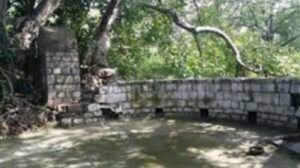
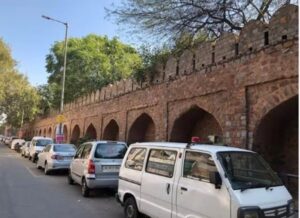
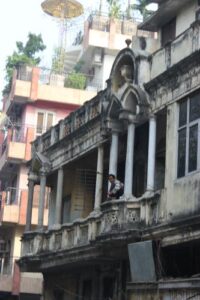
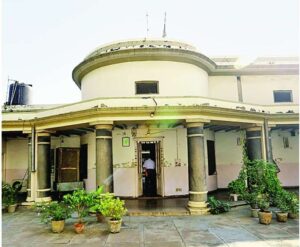
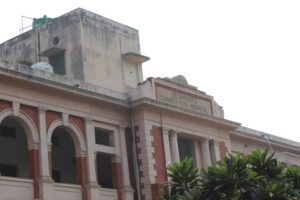

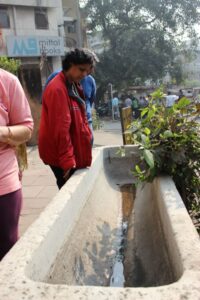

1 Comment
these are great piece of information thanks…can you please share or reupload these photos as they are not visible.